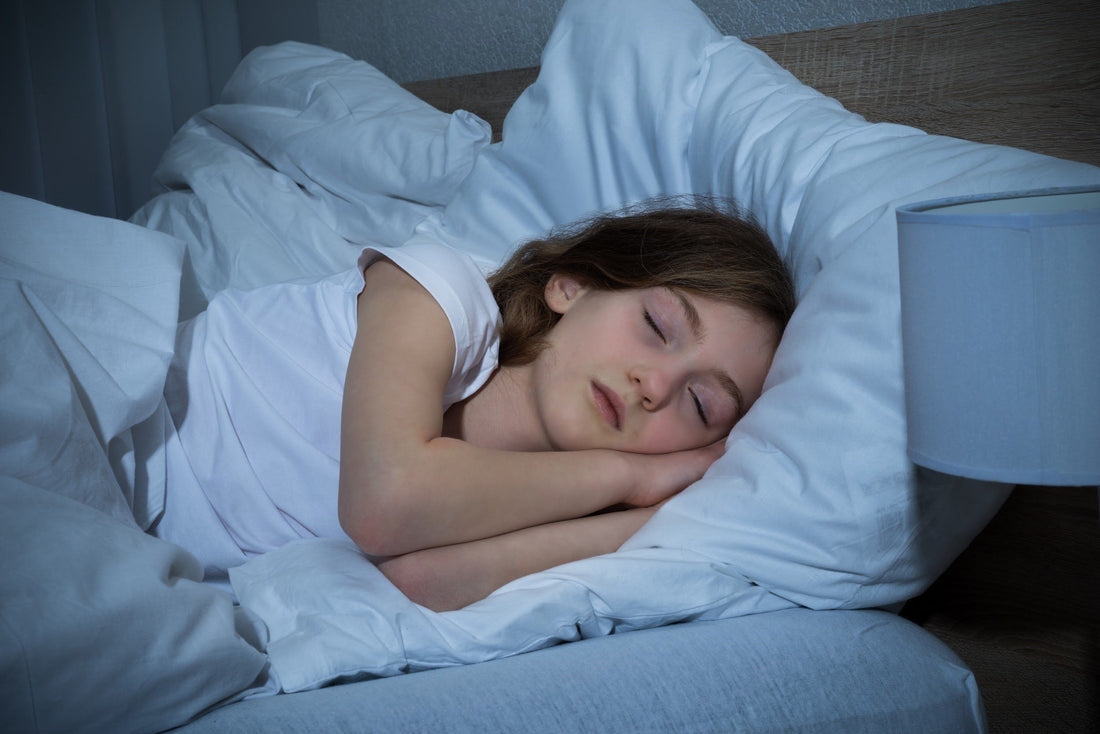How to Help Your Child Fall & Stay Asleep
Getting adequate sleep and waking up feeling well-rested sounds simple, right? Falling asleep fast isn’t so easy, and it’s often a source of frustration and anxiety for both parents and children. Children who are anxious might get wound up right before sleep, or they might have increased stress and worry that causes bedtime to be a battle instead of a time to reset and recharge. Through some trial and error, you can find ways to tailor your child’s bedtime routine to her needs.
What’s the Key to a Bedtime Routine?
Establishing bedtime routines for kids is crucial for promoting a healthy sleep pattern and overall well-being. A consistent routine signals to the body that it's time to wind down, helping improve the quality of sleep by aligning the circadian rhythm (body clock). Try to follow the same order of pre-bedtime steps so it becomes second nature for your child: bathing, brushing teeth, putting on pajamas, etc. We’ll talk further below about how to also integrate a bedtime ritual into your routine with relaxing activities such as reading, gentle stretching, or listening to soft music.
Furthermore, creating a safe sleep environment is crucial if your child is very young. The American Academy of Pediatrics offers the following tips for safe sleep:
- Place infants on their backs in their own sleep space with no other people.
- Infants should sleep in a crib, bassinet or portable play yard with a firm, flat mattress and a fitted sheet. Avoid letting your child sleep on a couch or armchair or in a seating device, like a swing or car safety seat (except while riding in the car).
- Ensure your child’s sleep space is free from loose blankets, pillows, stuffed animals, or other soft items.
These basic safe sleeping guidelines help to create a healthy and safe sleep foundation to foster proper sleep as they grow older.
Sleep Solutions: How to Help Kids Who Have Trouble Sleeping
According to the American Academy of Family Physicians, up to 50% of children will experience a sleep problem at some point in their childhood. It’s important for parents to identify these sleep problems to prevent negative consequences in other areas of their lives, such as daytime sleepiness, which can interfere with learning, irritability, behavioral issues, and poor academic performance.
Along with identifying sleep problems, helping children establish healthy sleep habits is crucial, but it’s also a common challenge for many parents whose children struggle with falling asleep. Fortunately, there are various strategies that can make bedtime a smoother experience for both kids and parents alike. From setting a consistent bedtime to incorporating calming bedtime rituals, these approaches contribute to creating a conducive environment for a good night's sleep.

1. Set an Individualized Bedtime
According to the National Sleep Foundation, school-age kids need nine to 11 hours of sleep; however, seven to eight hours — or 12 — might be more appropriate for your child. You might find your child is more of a night owl, so putting him to bed early will just cause him to lie awake, staring at the clock and possibly becoming more frustrated and anxious. Alternatively, if your child rises with the sun, putting him to bed earlier might ensure he gets adequate sleep. Find what works for your child and his particular sleeping pattern and stick to a precise bedtime.

2. Keep Sleep & Wake-Up Times Consistent
It’s important not only to maintain a regular bedtime but also a regular wake-up time. It can be tempting to let your child sleep in on the weekends or holidays, but what feels like mercy or a treat actually causes symptoms similar to jet lag. You can still have leisurely mornings on the weekends, but make sure your child wakes up around the same time as he or she does during the week.

3. Create a Bedtime Ritual
Establishing a routine is the juicy part of the whole bedtime and wake-up experience. This ritual can last about 20 to 30 minutes and can include reading stories (nothing scary), listening to music, handing your child a stuffed animal, covering him or her with a weighted blanket or some other relaxing activity. The cool thing about a bedtime ritual is that it’s unique to you and your child — a special time you share together. Ask your child what he wants to do before bedtime, so they are a part of the planning process.

4. Reduce Screen Time and Excitement
Avoid roughhousing, watching TV or playing games right before bed. Those sorts of activities are stimulating and not conducive to falling asleep fast. Some experts suggest turning off the television or other screens at least two hours before bedtime. The light from the TV screens or monitors can disrupt melatonin, a hormone that plays an important role in sleep-wake cycles. Any kind of excitement or stress from your child’s environment can prevent her from falling asleep. Don’t engage in a fast physical activity and don’t play loud music. Doing so can increase cortisol, also known as the “stress hormone,” which affects your child’s ability to calm down and sleep. Rather, keep the lights dim after dinner, play soft instrumental or favorite music, or try diffusing essential oils like lavender to promote calm.

5. Use Comfort Strategies
Children who are anxious are especially prone to sleep problems. Their minds might race at night and they might worry about something bad happening to them or their loved ones. Trouble at school today can make them nervous about tomorrow and unable to sleep. They could be afraid of the dark. For a comforting experience, try meditating together or listen to a pre-recorded sleep meditation. Read books about being afraid of the dark so your child realizes they’re not the only one who gets scared at night. Try progressive muscle relaxation, during which you tense and relax muscles throughout your whole body. Let your child pick out his own special nightlight to make the bedroom an anxiety-free space. Use an app or pre-recorded soothing sounds, such as ocean waves. Give your child a transitional object — something that will provide comfort even when you’re not by his side. This item could be a stuffed animal, one of your sweaters, or a special stone or crystal.

6. Start an Exercise Routine
Not all of the ways to fall asleep involve what you do right before bedtime. Make sure your child gets physical activity during the day — at least three hours before bedtime. Exercise helps dissipate restlessness or hyperactivity, as long as you don’t exercise too close to bedtime. In addition to exercise, ensure your child drinks enough water during the day so that she doesn’t drink or eat too much in the hours before bedtime, which can cause a trip to the bathroom in the middle of the night. If your child is taking Brillia for anxiety, stress, or other symptoms, we recommend having your child take their dose at least two hours before bedtime.
The Importance of Relaxing Before Bed
Keep in mind that your own relaxation is just as important as your child’s when it comes to winding down before bed. If you are stressed or anxious, it’s likely your child will be affected by your energy and chances are you’ll find it difficult to fall asleep too. Then you’ll have a tired child and parent the following day. As you search for ways to help your child fall asleep, consider how you can improve your own bedtime routine–can you go to bed earlier? Can you reduce screen time before bed? Are there any relaxing rituals you’d like to add to your routine to help you drift away more easily?
How to Help Kids Fall Back to Sleep After Nightmares
Nightmares happen to everyone from time to time, but for anxious kids they can become a common occurrence that makes bedtime a dreaded part of the day. Navigating nightmares can be a challenging aspect of parenting, but supporting your child through the process of falling back to sleep can make a significant difference.
When kids are frightened by nightmares, offering comfort and reassurance is key. Begin by calmly acknowledging their feelings and providing a comforting presence. Encourage your child to share details about the dream if they're comfortable, helping them process the experience. And double down on establishing a consistent bedtime routine with a calming pre-bedtime ritual. According to the Mayo Clinic, establishing a relaxing routine before bed may help reduce the frequency and intensity of nightmares. With patience and a comforting routine, you can help your child feel safe and ease back into a restful sleep after a distressing nightmare, and you can make bedtime one of their favorite times of day.
Learn more tips and strategies on how to help your child sleep better and manage their anxiety more effectively at the Brillia(nce) Resource Center.







